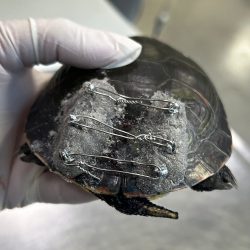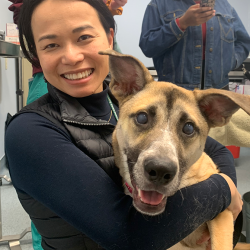By Sarah Shull, DVM, CCRT
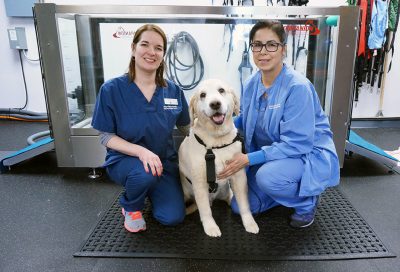
According to the American Kennel Club (AKC), Golden Retrievers were the third most popular breed in the United States in 2017 and have consistently been in the top 10 for the past decade. The total number of Goldens in households is difficult to assess, but approximately 50,000 are newly registered with the AKC each year. Based on their average lifespan of 10 years, the number of registered Goldens is 500,000. This number is estimated to represent less than 10 percent of the total breed population, as many are unregistered.
In addition to their friendly, energetic, and likable dispositions, Goldens also are known for something else—hip dysplasia. Less desirable than their personality attributes, hip dysplasia is a complex, multifactorial condition that involves multiple genetic and environmental factors. The best agreed upon preventatives are to screen breeding dogs via PennHip, a program that evaluates the quality of the hips in dogs, or the Orthopedic Foundation of America (OFA), and to uphold proper lean-body condition throughout the dog’s life. This includes restricting juvenile animals from repetitive, high-impact activities.
Per the statistics collected by the OFA, 152,272 radiographs for hip dysplasia have been evaluated since 1974. Of those, the incidence of abnormal hip joints is approximately 20 percent. Again, this estimation is low, as many affected dogs do not have their radiographs submitted through the OFA.
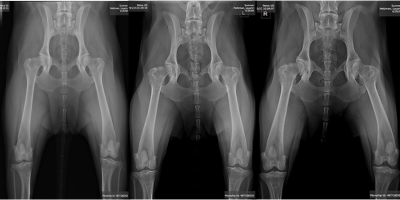
Summer Heitzman is a 10-year-old spayed female Golden Retriever that began working with the MSU Veterinary Medical Center’s Rehabilitation Service at the Dr. Elwood and Linda Collins Rehab Center, in January 2014. It was discovered that she has hip dysplasia through a proactive radiograph taken prior to her first visit to the Rehabilitation Service. Her owners are working closely with Dr. Hector Alfonso (DVM ‘91) of Okemos Animal Hospital. As her primary care veterinarian, Dr. Alfonso performs all of Summer’s radiographs, blood work monitoring, and general health care.
What is hip dysplasia?
Per Dr. Karen Perry, of the Hospital’s Orthopedic Service, hip dysplasia is a progressive and irreversible disease. It tends to present at 2 different times in a dog’s life. The first is during skeletal immaturity when canines are between 6 and 14 months of age; these signs are predominantly due to loose hips. The second is when canines reach skeletal maturity (4- and -8-years-old); these signs are primarily due to osteoarthritis (OA). Hip dysplasia diagnosis is made through a pelvic radiograph where veterinarians look at the hip socket (acetabulum) in relation to the head of the femur to determine if there is a proper fit or if there are any secondary arthritic changes. Once OA is present on a radiograph, dysplastic changes are irreversible and usually continue to progress over time.
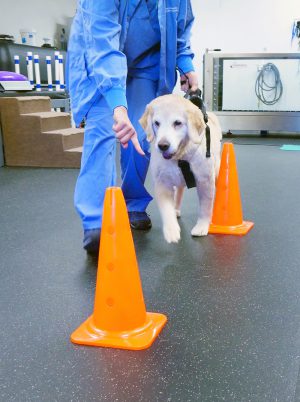
Studies have shown that up to 76 percent of dysplastic dogs with osteoarthritic changes on radiographs are able to function and live comfortable, quality lives with conservative management. Conservative management includes exercise modification, physical rehabilitation, and anti-inflammatory and analgesic medications. For the cases in which canines do not respond to this method of management, surgery, such as a total hip replacement or femoral head and neck excision (FHNE), may be recommended. Even with a prosthesis (total hip replacement) in place, or an FHNE, OA may still develop in the opposite hip joint and cause ongoing problems that require constant conservative or surgical management.
With appropriate treatment, however, the prognosis for long-term comfort and function is good to excellent. Exercise modifications are typically tailored to avoid activities that cause limping and decrease high-impact type forces. If the dog is overweight, a weight-loss plan would be recommended as excess fat promotes OA. At-home exercises and rehabilitation help maintain muscle tone and strength while stabilizing the joint. The goals of the exercises are to help to maintain range of motion in the joint and prevent compensation, and promote body awareness, sense of proprioception, and core strength to avoid injury. Medical management involves anti-inflammatories, such as nonsteroidal anti-inflammatory drugs, and chronic pain medications. Additional medications may include injections that protect the joints. Treating the pain and inflammation in hip dysplasia patients is extremely important, as pain limits mobility, joint range of motion, and decreases quality and quantity of life.
How is Summer’s hip dysplasia treated?
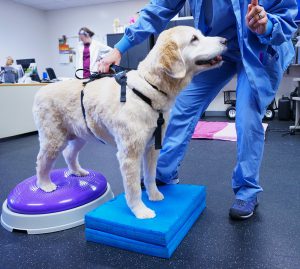
Summer takes nonsteroidal anti-inflammatory drugs and eats egg whites as a protein additive to her food. She also completes rehabilitation therapy at the MSU Veterinary Medical Center once a week.
She starts her day with a 23–25-minute walk on the underwater-treadmill at 1.0 mph. This speed and time equates to her walking approximately 686 yards. The water allows Summer to bear only 70–80 percent of her body-weight, which lessens the impact on her hips, while she is walking. The water contact also increases sensation and the moving treadmill belt increases multiple-joint range of motion.
After her water exercise, Summer rests before she begins therapeutic exercises. There are seven different exercises prescribed to Summer; based on her strength and mobility, her exercises vary each rehabilitation session. While exercising, she is monitored for signs of fatigue, pain, and poor posture, as the Rehab team pushes her to maximum potential to achieve the greatest therapeutic benefit.
After she completes the exercises, she receives a therapeutic laser treatment of her hip and lower back region. The laser has factory presets for her weight, body type, and hair coat length and color. This type of laser therapy has proposed benefits of increased circulation and improved tissue repair with decreased pain and inflammation.
How is Summer doing now?
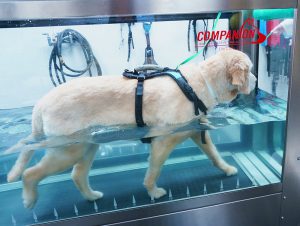
Although her hip OA already began progressing (as seen from her radiographs), Summer’s mobility and quality of life have been maintained through conservative medical management and rehabilitation.
Summer’s case is an example of a common condition that can benefit from close collaboration among primary care veterinarians, owners, and a specialized veterinary medical service. Through the relationship among Dr. Alfonso, Summer’s owners, and the Hospital’s Rehabilitation Service, Summer’s care has been proactive, dynamic, and tailored to her needs. The early intervention allowed her to maintain mobility and quality of life for both her and her owners.


